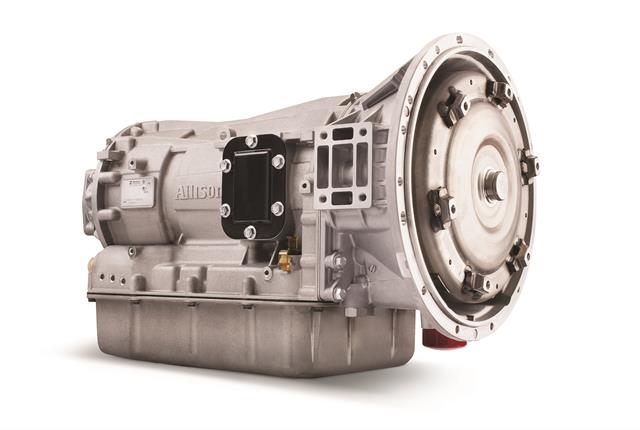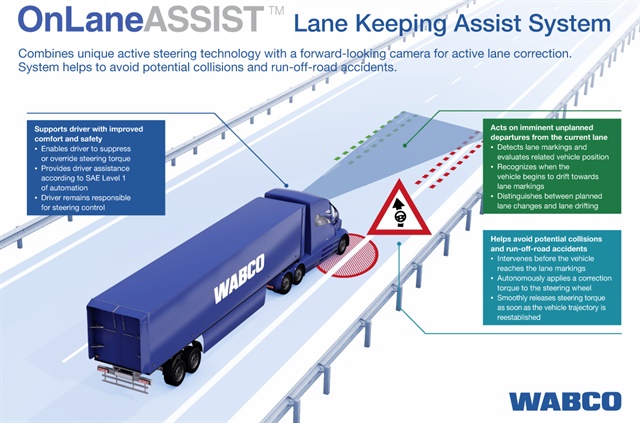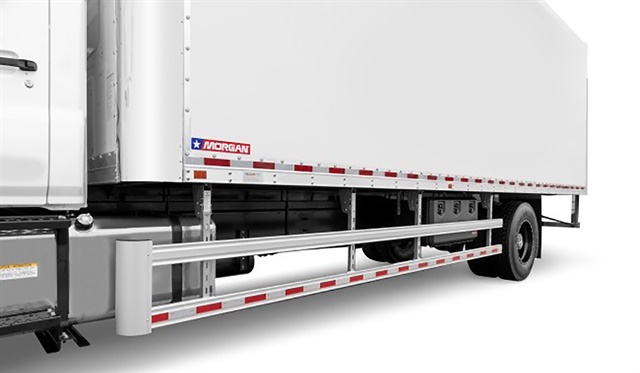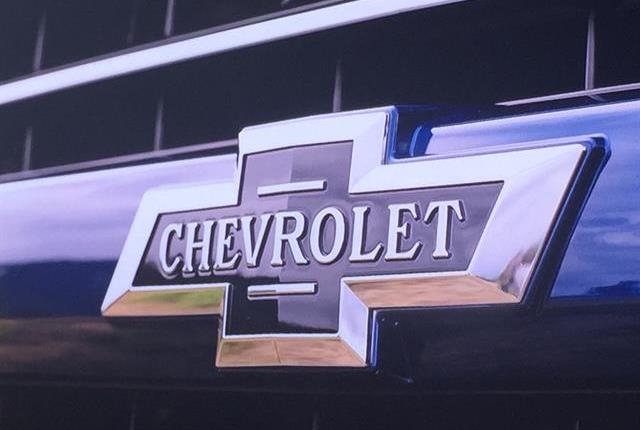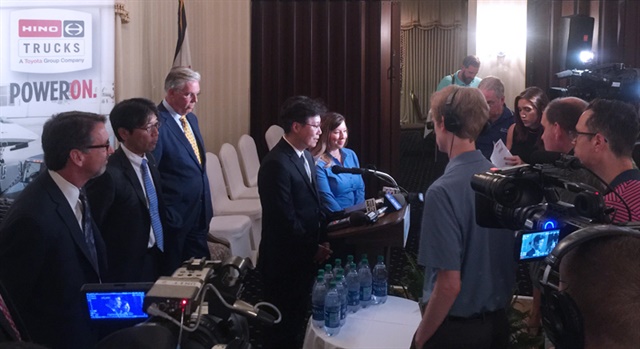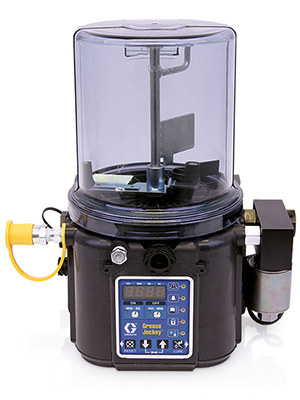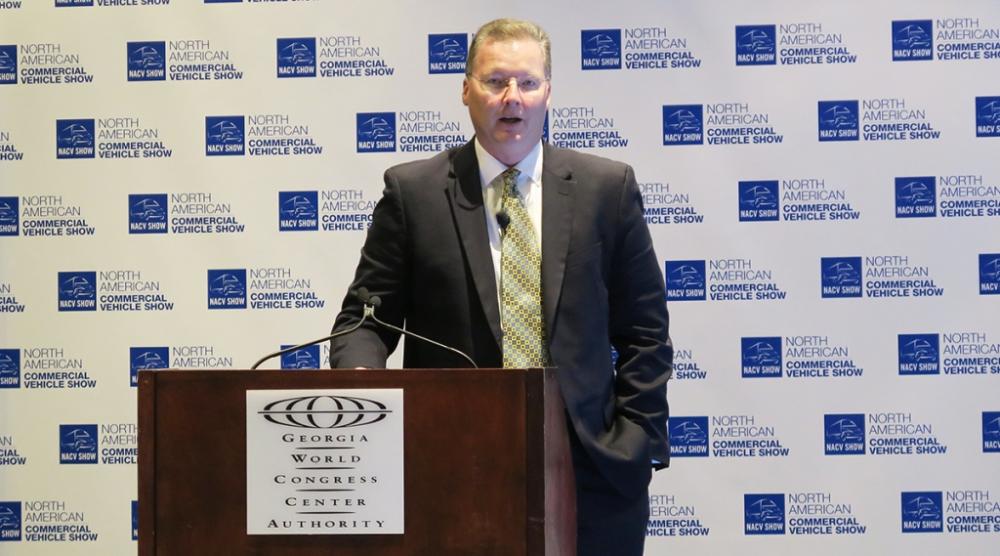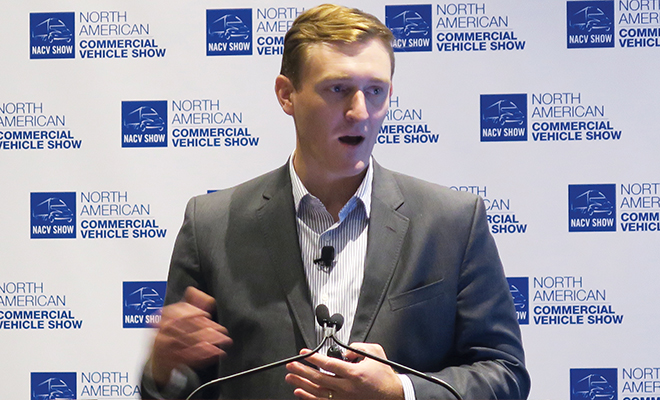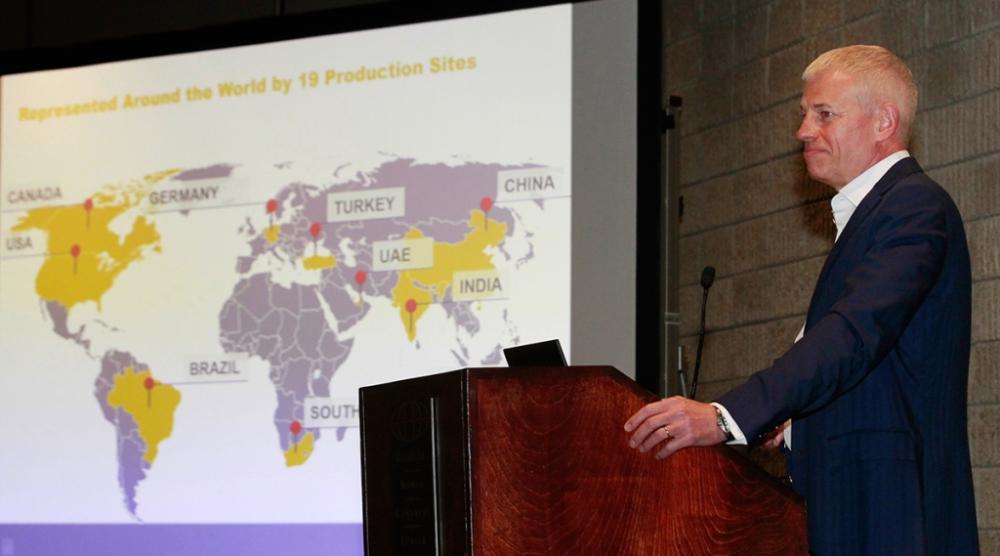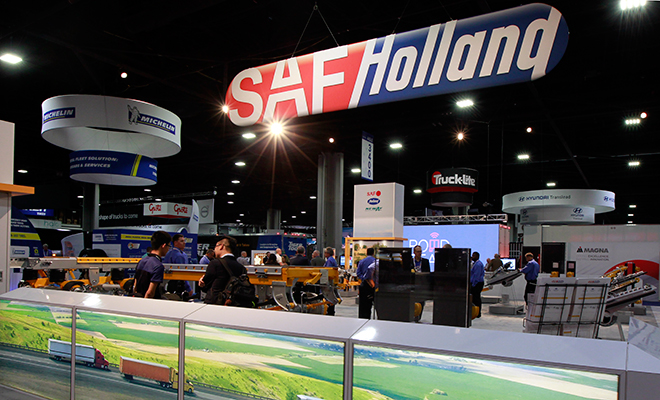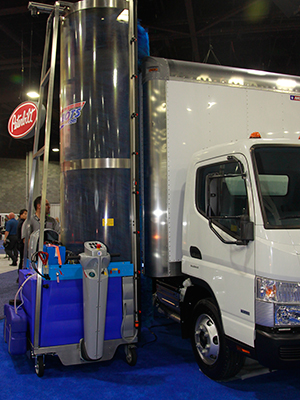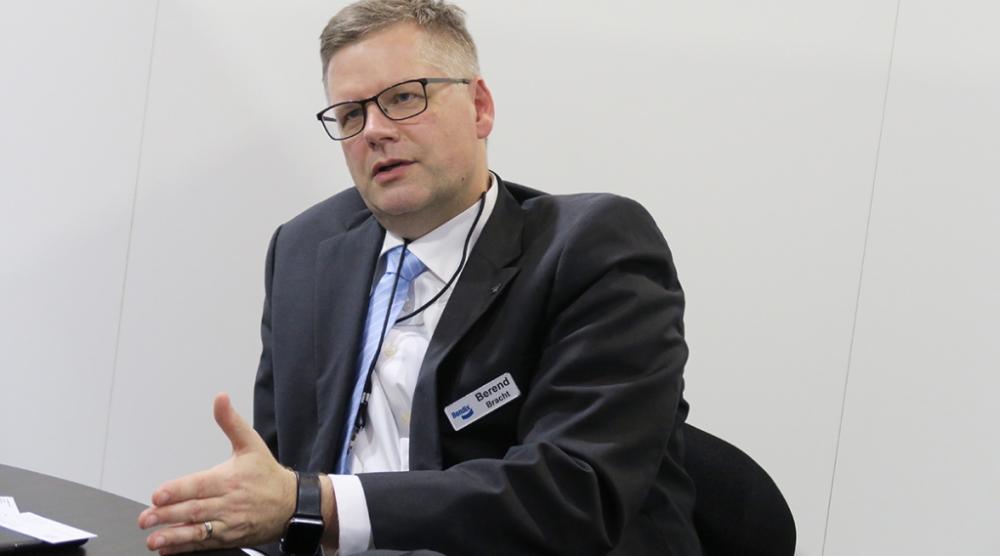
kscarbel2
Moderator-
Posts
18,886 -
Joined
-
Days Won
114
Content Type
Profiles
Forums
Gallery
Events
Blogs
BMT Wiki
Collections
Store
Everything posted by kscarbel2
-
Allison plans new nine-speed automatic transmission
kscarbel2 replied to kscarbel2's topic in Trucking News
Allison to Bring 9-Speed Automatic Transmission to Market by 2020 Heavy Duty Trucking (HDT) / September 28, 2017 ATLANTA – Allison Transmission plans to release the first 9-speed fully automatic transmission in 2020, offering fuel savings and available to help meet the next round of greenhouse gas emissions standards. At the North American Commercial Vehicle Show, company officials said the fully automatic transmission for medium- and heavy-duty vehicles will be available globally and is targeted for release in 2020. The new 9-speed transmission has a deep first gear ratio, includes an integral engine stop-start system, and is scheduled to be released in time for the EPA's GHG Phase 2 emissions standards. “This 9-speed product launch represents the first in a number of new products which will demonstrate Allison's ongoing commitment to addressing the global challenge of improved fuel efficiency and reduced greenhouse gases,” said Randy Kirk, senior vice president -product engineering and product teams. The new 9-speed will reach up to 7% greater fuel efficiency than the base 6-speed model, he added. “Customers can also expect up to 10% greater [fuel economy] or more when compared to a competing transmission.” The new transmission marks the first of its kind for the medium-duty market and is ideal for Classes 3-7, especially distribution trucks, rental and lease trucks, and buses, Kirk said. With the new transmission, drivers can also look forward to better comfort due to smaller steps, a smoother start, and improved acceleration, Allison says. “Many OEMs in North America, Europe and Asia have expressed interest and excitement, with prototype evaluations beginning for them yet this year," Kirk said. “This is the first in a number of new products we’ll develop to meet the global challenge of increased fuel efficiency and reduced greenhouse gas emissions." . -
Wabco Launches OnLaneAssist Driver Assistance System Heavy Duty Trucking (HDT) / September 28, 2017 ATLANTA — Wabco has launched the OnLaneAssist advanced driver assistance system designed to prevent unintended lane departures with an active steering functionality. OnLaneAssist leverages active steering technology and a forward-looking camera to provide active lane correction functionality. OnLaneAssist detects lane markings and continuously evaluating the vehicle’s position relative to them. It also distinguishes between planned lane changes and lane drifting. When it detects lane drifting, the system autonomously intervenes before the vehicle leaves the lane by applying correction torque to the steering wheel to return the vehicle to the center of a lane. OnLaneAssist then releases the torque as soon as the proper driving path is reestablished. The launch follows Wabco’s acquisition of R.H. Sheppard, a supplier of steering technologies and the signing of a cooperation agreement with Nexteer Automotive which develops intuitive motion control technology. OnLaneAssist is Wabco’s first ADAS based on Sheppard’s steering technology integrated with Nexteer’s steering automation technology. Wabco’s acquisition of Sheppard provided key capabilities for lateral vehicle control through active steering, complementing Wabco’s technologies in longitudinal control through active braking, stability, and suspension controls. Full dynamic control of commercial vehicles – lateral and longitudinal – is necessary to progressively achieve the industry’s vision of autonomous driving, according to Wabco. “OnLaneAssist represents another important milestone on the commercial vehicle industry’s roadmap towards autonomous driving,” said Jorge Solis, Wabco president, truck, bus and car original equipment manufacturers division. “This advancement demonstrates Wabco’s capability to address the challenges of lateral vehicle dynamics control – furthering progress on the path to self-driving commercial vehicles.” .
-
Heavy Duty Trucking (HDT) / September 28, 2017 ATLANTA — Thermo King is making it easier for fleets to make use of the data from their refrigeration units by shipping its Precedent reefers already equipped with its TracKing asset management system. The intelligent reefer system allows fleets to monitor and analyze refrigerated operations to ensure temperature compliance and improve uptime. While it's previously been an option, now Precedent reefers will come from the factory already equipped with TracKing -- all the owner has to do is contact Thermo King to activate the subscription-based service, explained Gayatri Abbott, Connected Solutions product manager, in an interview at the North American Commercial Vehicle Show, comparing it to the way SiriusXM satellite radio comes in new cars, but customers have to activate a subscription. Thermo King’s Connected Solutions offer users a robust, secure platform that collects and aggregates data for a large number of mobile assets, such as location, reefer temperature, ambient temperature, fuel levels, battery charge, open doors, and other data. While TracKing has been an option for many years, Abbott explained, the adoption of the technology has skyrocketed in the past couple of years, thanks in part to new regulations requiring more accountability in the food chain, the Food Safety Modernization Act (FSMA). Access to real-time data and diagnostics is useful for fleet operations, dispatch, planning, and maintenance personnel. Access to the data also enables Thermo King dealers to serve as advisors. "The less I physically see my assets, the more I want to know," Abbott said. With the way indsutry and regulatory trends were going, she said, "we reallized TracKing needs to be on every unit." With in-cab and in-yard access via the Thermo King Reefer mobile app using Bluetooth, drivers can manage cargo temperatures, monitor the reefer and respond to alerts all within the cab. Similarly, in-yard access makes it even easier to prepare reefers for trips ensuring that they are fueled and alarm-free.
-
Heavy Duty Trucking (HDT) / September 28, 2017 Morgan Corporation is set to release improved side- and rear-steps, plastic toolboxes, and side-guard protection devices for truck bodies, the company announced. The new side- and rear-step designs and dent resistant plastic toolboxes are lighter than traditional metal toolboxes. They are also sealed to prevent water intrusions. The importance of side guard protection in North America, especially in many of the major urban areas, is steadily increasing, according to Alex Epstein, an engineer with the U.S. Department of Transportation. Truck side guards are intended to sweep aside pedestrians and bicyclists in side-impact crashes, rather than being swept underneath the vehicle, Epstein said. A number of U.S. cities and commercial insurers have joined 47 countries in requiring the use of side guards over the past five years. .
-
Heavy Duty Trucking (HDT) / September 28, 2017 Chevrolet will offer Class 4 and 5 versions of its Silverado for commercial users in fields such as construction, utility services, and first responders, the company announced at the Texas Auto Show. Chevrolet will initially offer 4500 and 5500 Silverado medium-duty trucks as chassis cabs when the trucks go on sale in 2018. The company will release additional details about the vehicles later this year. “The focus is really on commercial truck users,” said Sandor Piszar, director of Chevrolet Truck marketing. Both the Silverado 4500 and 5500 will be available in regular and crew-cab models, with 4x2 and 4x4 capability and a wide range of GVWRs and wheelbases, according to the automaker. The trucks will be available with optional OnStar with 4G LTE connectivity provided by AT&T. All Silverado 4500 and 5500 models will be powered by a Duramax diesel engine and Allison transmission, Chevrolet said in a release. The move comes as Chevrolet is expanding its commercial truck lineup. Earlier this year the company announced it will offer a class 6 Low-Cab Forward model. The company is also developing a medium-duty straight truck in a partnership with Navistar. .
-
Hino to launch heavy trucks in North America
kscarbel2 replied to kscarbel2's topic in Trucking News
Hino to open new WV plant, introduce new line of Class 7 and 8 trucks Fleet Owner / September 28, 2017 Company also building new Michigan headquarters Hino plans to strengthen its U.S. operations with the introduction of a new truck line and new facilities. At a press conference yesterday, Hino announced its plan to purchase a former Coldwater Creek women's clothing distribution center and convert it into a new Hino truck assembly plant in Mineral Wells, WV, close to the current Hino plant. The new facility is expected to open in early 2019 and will also house cab assembly, which is currently done in Japan. "The new plant, which is four times the size of our current plant, will allow us to combine several assembly operations under one roof which will provide significant efficiency gains," said Takashi Ono, the Hino Motors Manufacturing U.S.A. president. "West Virginia has enjoyed a very good relationship with Hino," Jim Justice, the state's governor, said. This new plant demonstrates that Hino has confidence in our state, and West Virginia is a great place to do business. On behalf of everyone in the Mountain State, I thank Hino for their continued investment and the creation of new jobs." Hino plans to invest $100 million in the new plant, creating about 250 new jobs by early 2020 over a two-shift operation. In addition to producing Hino's current lineup of conventional trucks, the plant will produce a new line of Class 7 and 8 trucks that Hino plans to introduce in 2019. The truck will be powered by Hino's A09, 9-liter engine. Already sold in many other markets around the world, the Hino A09 engine has a horsepower range of 300-360 HP. Hino is planning a public reveal of the new truck at the 2018 NTEA Work Truck Show. "These are truly exciting times for Hino in the U.S.," said Yoshinori Noguchi, CEO of Hino North America. "Our growth and customer acceptance in the Class 4-7 market are enabling us to introduce wider variety of products." As part of Hino's growth plan, the company broke ground on a $20-million corporate office in Novi, MI, in August. Hino is consolidating all operations in its new corporate headquarters, including sales, marketing, service, engineering, purchasing, and manufacturing. Hino's Insight Diagnostic Center, which monitors vehicle performance and uptime for all Hino trucks equipped with Insight, will also operate out of the Novi headquarters. -
Heavy Duty Trucking (HDT) / September 28, 2017 Hino announced that it plans to produce a new line of Class 7 and 8 trucks at a new truck assembly plant in West Virginia, starting in 2019. The new larger trucks will be powered by Hino’s A09 9-liter engine that is already sold in other markets globally. The engine will produce from 300-360 horsepower. The truck is scheduled to be publicly revealed at the NTEA Work Truck Show next March. “These are truly exciting times for Hino in the U.S.,” said Yoshinori Noguchi, CEO of Hino North America. “Our growth and customer acceptance in the Class 4-7 market are enabling us to introduce a wider variety of products.” The new vehicles and facilities are part of a $100 million investment plan to strengthen its U.S. operations. Hino is purchasing the former Cold Water Creek distribution center and converting it into its new truck assembly plant in Mineral Wells, West Virginia. The new plant is expected to be operational by 2019 and will also house cab assembly, an operation currently conducted in Japan. As part of Hino’s growth plan, the company broke ground on a new corporate office in Novi, Michigan, and is consolidating all operations into its new corporate headquarters. including sales, marketing, service, engineering, purchasing, and manufacturing. Hino’s Insight Diagnostic Center, which monitors vehicle performance and uptime for all Hino trucks equipped with Insight, will also operate out of the Novi headquarters. Hino Motors currently produces Class 6 and 7 conventional body style trucks in the 245,000-square-foot former Walker Systems building in Williamstown, West Virginia. The Williamstown facility was the first transportation equipment assembly plant for Hino in the United States. Hino began rolling out its first trucks in November 2007, and last month celebrated its 10-year anniversary there. .
-
Transport Topics / September 28, 2017 ATLANTA — To provide an alternative to manual lubrication, Graco Inc. unveiled its new electric grease jockey pump at the inaugural North American Commercial Vehicle Show. The state-of-the-art device, featuring rugged construction, a data management system and low level signal, aims to achieve greater productivity for staff handling equipment and maintenance. Also, it offers in-cab feedback, integrated controls, and NLGI #2 compatibility at a price point in the $3,000 range. Multiple mounting and plumbing options are available. “Why even have that truck wait for a half a day, because most of the fleets are having a shortage of mechanics and technicians,” Dan Jensen, global product marketing manager with the lubrication equipment division, told Transport Topics on Sept. 28. “If a truck came off the road and they had a guy with a grease gun ready to jump on it, that’d be one thing. [In] most cases, they don’t.” Earlier this month, the Minnesota-based manufacturer of fluid handling equipment added the new A4000 Reciprocating LubePro oil and grease pump to the LubePro series of automatic lubrication pumps. “With the launch of the A4000 Reciprocating LubePro pump, we now offer a full portfolio of single-line parallel solutions,” Andrew Gerlach, the company’s industrial lubrication equipment product marketing manager, said in a statement Sept. 22. “Additionally, our engineering team designed a creative mounting solution that allows for easy installation.” .
-
Editorial: The First Swing at Bat Transport Topics / September 28, 2017 The inaugural North American Commercial Vehicle Show was marked by big swings from truck manufacturers, both in terms of their displays, and in what they had to say. Electricity was in the air at Daimler’s events, as electric power for the trucks of tomorrow — and today — was the hot topic. Those in attendance at a party the company hosted the night before the show kicked off were given an early peek at this theme, as Martin Daum, head of Daimler’s global truck and bus business, said that his company is researching how to extend the operating range and hauling capacity of heavy-duty, electric-powered trucks. The next day, during a 90-minute press event designed to mimic a morning news show — complete with a pair of hosts, guests and correspondents — the company showcased, among many other things, an electric-powered version of the Canter medium-duty cabover from Daimler’s Mitsubishi Fuso brand. Dubbed eCanter, the truck will soon enter duty with UPS Inc. and a selection of New York-based organizations. A Daimler rep noted during the Sept. 25 show-within-a-show, the next generation is already under development. Navistar Inc. is also getting in on the electric action, announcing that it is developing a Class 6/7 electric truck, but at NACV it focused its introductions on more conventional products, unveiling a new medium-duty model and announcing that it will work with new corporate partner Volkswagen on a new line of global, big-bore engines. The announcement of the engine pact is an important next step for the company, following the launch earlier this year of a new proprietary engine. And the debut of the new truck is the latest in a succession of product launches for the company. All of this is part and parcel of Navistar’s march to recover from its recent financial troubles, and the flashy press event it hosted at NACV showed that it’s ready to make some noise. Both Volvo and Mack showcased the new models they’ve recently launched, taking big swings at an on-highway market that has been dominated by their rivals, while also laying claim to the regional and vocational segments that have traditionally been strengths. The fact that all of these companies had new trucks to tout at the show (Paccar Inc. was not present) is indicative of the exciting times we’re living in, and of the fortunate timing of this inaugural NACV. It’ll be two years before we see if show organizers — and exhibitors — can recreate this kind of excitement. But for the first time at bat, we’d call NACV a hit.
-
Transport Topics / September 28, 2017 ATLANTA — Truck-leasing provider Ryder System Inc. has signed an exclusive agreement with Aperia Technologies to implement automatic tire inflation as a standard specification across its heavy-duty rental fleet. Through that partnership, Ryder will equip all new heavy-duty rental trucks with Aperia’s Halo Tire Inflator systems, the companies announced Sept. 27 during a joint press conference here at the North American Commercial Vehicle Show. Ryder already has an advanced tire-pressure management program for its trucks, but “once that product leaves our possession, tire inflation becomes a major issue,” said Scott Perry, Ryder’s chief technology and procurement officer. Inadequate tire pressure can weaken fuel efficiency and lead to tire failures, which are a major source of downtime for fleet customers and a drain on Ryder’s service operations, he said. “This is a product and a relationship that we think is going to have a significant impact on our overall operations and cost and our value proposition to our customers,” Perry said. Josh Carter, co-founder and CEO of Aperia, said the Halo system can boost fuel efficiency by 1-2% and extend tire life by 10-15% while improving safety and vehicle uptime. Halo is a bolt-on system that uses the wheel’s rotational motion to pump and maintain ideal tire pressure. The product’s design enables it to be installed on both tractors and trailers, unlike traditional automatic inflation systems that route air lines through the axles and are focused mostly on the trailer. “We’re really excited to be able to bring the value to other wheel positions for our customers,” Carter said. Perry said Ryder already has installed the Halo system on “hundreds” of rental trucks and will continue to deploy the system rapidly as it replenishes its fleet. Beyond its rental trucks, Ryder said it will make the Halo system the preferred tire inflation option for its long-term lease customers. Ryder also plans to offer the Halo system through its SelectCare service, where Ryder provides full-service maintenance and support for customer-owned vehicles. Perry said the Halo units are simple to maintain. “That’s really the beauty of this product,” he said. “This is as close to a zero-maintenance product as you can get once it’s installed, and that was a key driver of the decision-making process for us.” .
-
SAF-Holland unveils new lift axle, retrofit for lighted fifth wheel
kscarbel2 replied to kscarbel2's topic in Trucking News
SAF-Holland Displays Suspension System, Retrofit Kit Transport Topics / September 28, 2017 ATLANTA — International Tier 1 supplier SAF-Holland introduced a new lift-axle suspension system for heavy-duty trucks and a retrofit kit for its fifth-wheel coupling system. SAF executives also made a presentation for donating almost $74,080 to the Wyakin Foundation of Boise, Idaho, which helps prepare U.S. veterans for civilian careers. The company’s U.S. operations are based in Muskegon, Mich., and management made the announcements Sept. 27 here at the North American Commercial Vehicle Show. The parent company has headquarters in Luxembourg and its three major North American brands are SAF, Holland and Neway. The new product is the large-capacity Neway LSZ auxiliary, steerable, lift-axle suspension system for vocational trucks that often haul heavy loads. The system has an 18.3-inch package size as part of a design that is up to eight inches shorter than comparable lift axles. The company said this allows LSZ to fit where other lift axles cannot, thereby providing extra frame rail space for other uses. “If the LSZ is spec’d on a new truck, it may reduce the truck’s overall wheelbase to provide extra maneuverability,” said Jason Heath, a Neway product manager. Lift axles help heavy-haul trucks comply with the bridge formula for weight distribution. When a truck is fully loaded, more weight-bearing wheels are lowered to the pavement. When the truck is empty, the wheels are lifted to improve fuel mileage. Heath said the LSZ lifts quickly and reduces bouncing. Dump trucks, refuse haulers, concrete mixers and pumpers, logging trucks and cranes are among the potential customers, he said. The retrofit kit is for Holland’s electronic lock indicator, ELI-te, to be added to FW35 series fifth wheels. ELI-te is designed to make sure a trailer’s king pin is securely fastened to the tractor’s fifth wheel. Tom Bronz, Holland’s director of aftermarket sales, said the retrofit kit takes about 45 to 90 minutes per tractor to install. The job entails modifications to the existing fifth wheel’s top plate. “The lights make it easy for drivers to positively confirm that they have coupled correctly, and warn them if they have not. It’s a new generation of safety,” Bronz said. Regarding the charitable donation, Carl Mesker, vice president for SAF-Holland aftermarket, said, “The Wyakin Foundation is an outstanding organization where a large percentage of every dollar counts toward helping veterans transition into our industry. We need more great people in the heavy duty industry and the Wyakin Foundation can be a resource for every supplier in this industry. We are excited about the success of our promotion, and appreciate the outstanding participation from our HDA Truck Pride members.” SAF-Holland CEO Detlef Borghardt was also at the presentation. He said the corporation’s major customers are trailer makers, providing 60% of revenue; truck makers, 15%; and aftermarket, 25% of sales. Global 2016 sales for the company were the equivalent of $1.15 billion. . -
New Wash-Bots to Enhance Cleaning Experience
kscarbel2 replied to kscarbel2's topic in Trucking News
. -
Transport Topics / September 28, 2017 ATLANTA — An enhanced machine for washing trailers and buses was showcased at the North American Commercial Vehicle Show. Bitimec Wash-Bots demonstrated its new 626 EZ model, which is designed to be a faster tool for attending to up to 30 buses or trailers in one charge of the batteries. The battery operated machine is relatively quiet, and emission-free. Also, it is ideal for uses both indoors or outdoors. With an elegant, tall look, and dynamic blue bristles adequate for a variety of vehicles, the machines are expected to facilitate the cleaning experience at hubs and warehouses. “It’ll do the job in about six to eight minutes. One operator can wash about 30 to 40 trucks in one shift. And we have people doing that. We have people doing that at different companies,” Bruno Albanesi, president at Bitimec International Inc., told Transport Topics on Sept. 27. “It’s really a handy machine for these guys to have,” he added, as a colleague demonstrated the machine inside the expansive convention floor. Several firms have chosen the new, state-of-the-art wash-bots. These include Texas-based Keg 1, Divine Charter of Phoenix, Ariz., and the distributor Indiana Beverage. .
-
Transport Topics / September 27, 2017 ATLANTA — Trailers are on the verge of delivering more than just freight. A bevy of additional sensors linked to various components are coming to trailers to relay increasing amounts of data, suppliers said. The suppliers made their comments during a symposium hosted by Utility Trailer Manufacturing Co. at the inaugural North American Commercial Vehicle Show here Sept. 27. “The demand for data is simply everywhere. In the past, data was collected on the exception basis when something [unusual] was going on. We feel data will be collected continuously in the future,” said Bendix Commercial Vehicle Systems CEO Berend Bracht. With the near certainty of truck platoons before too long, knowing exactly what the braking system is not just on the various trucks but also the trailers seeking to join up is crucial, he said. The important question to answer is, “Who benefits from the information, and how quick do they need to get it?” said David Kiefer, director of sales and marketing and product management at Carrier Transicold. With so much data available, the key is converting it to something useful for decision making, he said. “If you have a pending issue where something is going to break or you are going to lose your [refrigerated load], you would want to do something in real time,” Kiefer said. “And if you have something in between, maybe it goes to dispatch and they can filter it and decide if it needs to go to the driver.” The ideal state for a fleet, he suggested, was to have all the systems on the trailer “talking,” then receive a single bill for all of the airtime, and worst case go to a website for information and best case have information integrated into your back office system. .
-
Transport Topics / September 27, 2017 ATLANTA — Disruptions of supply chain operations are coming and will shake up the trucking industry from fleets to suppliers, an executive with one truck maker said, adding it was time for the industry to get “paranoid.” “The industry will really look different, and we better all be prepared for that because there is change coming,” said Persio Lisboa, chief operating officer at Navistar International Corp. Lisboa made the comments while delivering the keynote address at the annual Heavy Duty Manufacturers Association Breakfast and Briefing, which was part of the inaugural North American Commercial Vehicle Show here Sept. 27. Driving that disruptive change is the need to keep up with customers’ expectations of instant information and order delivery — or close to it, he said, adding those factors are reshaping the supply chain. Plus, there’s the need to reduce unplanned down time, increase driver safety and maximize asset utilization. To help with that, the industry has the emerging power of big data — built on connectivity — behind it, and that can improve supply chain operations and fleet performance, Lisboa said. Lisboa told the story of how, using “cluster methodology,” Navistar was able to gather data through its connected vehicle services application from participating carriers clustered in a geographic region. Navistar analyzed the information and compared the performance of the similarly operating carriers. One carrier in the group stood out as operating about three times less efficiently, he said. Navistar contacted that carrier and ultimately learned the carrier was using a spec that had been part of the way it operated for a long time, but it was causing the fuel efficiency of its trucks to fall. The company pointed that out to the carrier, and they changed the spec and improved its fuel efficiency. Meanwhile, connected vehicles will be the “backbone” of the digital supply chain, he said. Yet, about 70% of the trucks on the road don’t have telematics devices. “How do we reach them?” he asked. “That is a major opportunity for disruption” and for digital load-matching companies “to jump into our sector.” Navistar monitors about 350,000 trucks using its OnCommand Connection and stores 8.8 million miles of data each day, and can identify where and when 1.3 million gallons of fuel are consumed in those trucks, Lisboa said. As it turns out, Friday is the day with the highest fuel consumption, according to Navistar data. In addition, the federal government needs to pass regulations encouraging the use of automated trucks to make the roads safer. “We will see dedicated vehicles operating ramp-to-ramp,” he said. “Call it disruption, but in the end it is just productivity — it is just taking waste out of the system,” Lisboa said. The question is who is going to be in the forefront of the coming changes, he said.
-
FlowBelow Adds Quick-Release Option for Fairings
kscarbel2 replied to kscarbel2's topic in Trucking News
-
Transport Topics / September 27, 2017 ATLANTA — FlowBelow Aero Inc. announced a quick-release fairing option for its flagship Tractor AeroKit system. The company made its announcement at the inaugural North American Commercial Vehicle Show here Sept. 27. The quick-release mounting system allows the driver of the truck to remove the between-wheel fairings — intended to boost fuel efficiency — easily in seconds and without tools when installing tire chains, for example, according to the company. The Tractor AeroKit maximizes the aerodynamic performance of the company’s wheel covers by also controlling the airflow between and behind the wheels, according to FlowBelow. “By enhancing our AeroKit with quick-release fairings we are targeting customers that desperately want to achieve the maximum fuel savings possible without creating extra work for their mechanics or drivers,” FlowBelow’s founder and CEO Josh Butler said in a statement. The system is available through all Freightliner, Kenworth and Peterbilt dealers.
-
Inaugural NACV Draws Top Fleet Execs, Praise Transport Topics / September 28, 2017 ATLANTA — North American truck makers and their customers wrapped up the first of a new option for shopping for and even buying Class 8s, with manufacturers producing large, elaborate displays for a limited number of high-probability buyers: top fleet executives. The North American Commercial Vehicle Show ran here Sept. 25-28 for nearly 10,000 attendees who traipsed across 379,300 square feet of exhibits in the Georgia World Congress Center to check out what’s available in the truck market today and what’s planned for in the coming years. Five of the seven heavy-duty truck brands were the stars, but there were also top-tier suppliers to answer questions about their products. Trucking executives who spoke to Transport Topics said there was more shopping than buying, but shopping of consequence. U.S. Xpress Enterprises is preparing for the truckload carrier’s 2018 truck buy, some 1,500 to 2,000 tractors. “I’m in the middle of negotiations,” said Max Fuller, the company’s chairman. “We’ll complete this in the next three-to-six weeks,” he said, adding that his two-day visit was “extremely useful.” Fuller said he visited with truck, engine, transmission and tire makers. Then he looked into air disc brakes. “It’s a good place to compare products,” he said. Marten Transport Chairman and CEO Randolph Marten said, “It reminded me of the Hanover [Germany] show last year, where it was all set up with everything they made.” He said he did not go to buy vehicles, but that there was time for detailed conversations with supplier executives. In just one day there, Marten said, he met with three truck makers, major producers of refrigeration units Thermo King and Carrier Transicold, and some others. His Mondovi, Wis.-based company is the fifth-largest refrigerated carrier in North America. “If you wanted to know something, you could get it answered,” Marten said. Bill Reed, CEO of Skyline Transportation in Knoxville, Tenn., also attended for one day and said he shopped for trucks that emphasize driver amenities. He said he was “impressed” with the event and that it offers benefits for both sides. “I could do a lot of comparison shopping, and the OEMs had all of their customers in one place,” Reed said, referring to original equipment manufacturers. He did not make any purchases during the show, but Reed said he’ll be buying trucks during the first quarter of 2018 and the NACV visit will help with the process. NACV is scheduled to run in odd-numbered years and was set up as an alternative to the larger, older Mid-America Trucking Show that convenes annually in Louisville, Ky. “For a first edition, we’re happy but not satisfied. We know there are improvements to be made,” said Joe Glionna, president of NewCom Business Media, the Canadian half of the joint venture that created the NACV. The other partner is Germany’s Deutsche Messe, with U.S. arm Hannover Fairs. The show had 452 exhibitors who occupied 441 booth spaces. Some corporations with multiple brands put more than one exhibit in a booth. Glionna said he did not quite get the 10,000 visitors that he was hoping for, but “came close.” Final attendance figures will be published Oct. 2, he said. “We are extremely happy with the turnout of the show,” said Jeff Sass, senior vice president of sales and marketing for Navistar Inc. “We had the right customers there, heavy booth traffic and were proud to be a part of the inaugural year of this show. We’re already looking forward to 2019.” “The goal of the show, I think, is really excellent, in terms of connecting with fleets and connecting with customers,” said Jon Morrison, president of Wabco Holdings’ Americas division. Except for a new Navistar vocational model, all of the trucks on display had been introduced before the show, but Glionna said he expects that to change. “Some of the plans for new trucks are three or four years in the making,” so synchronization with 2017 NACV was not possible, he said. “But two years from now we’re definitely going to see truck and innovation launches,” Glionna said. As for innovation, there was consistency on what will come: autonomous, connected and electric vehicles. Connectivity has made the most progress so far, with all truck makers emphasizing in-truck telematics as one of the most important tools for not just preventive maintenance, but predictive fixes and improvements. Freightliner, Mack, Navistar, Volvo and Western Star all mentioned it. Electric vehicles are coming, all manufacturers said, but Class 8 highway tractors might take the longest. Medium-duty trucks, such as Class 6 or Class 7 models mentioned by Navistar, seem more likely to come first. But a Daimler executive said his company would like to one day make and sell a “Cascadia-E” electric tractor. Manufacturers said workable battery packs are becoming less expensive and less bulky over time due to much research. The autonomous angle was couched in terms of systems that assist drivers, rather than replace them. .
-
Cummins Eyes Eventual Expansion in Medium-Duty Market
kscarbel2 replied to kscarbel2's topic in Trucking News
https://www.bigmacktrucks.com/topic/35823-ford-re-launches-f-4000-at-brazil’s-agrishow/ http://www.fordcaminhoes.com.br/serie-f/f-4000 https://www.bigmacktrucks.com/topic/36835-ford’s-f-4000-to-return-in-september/ -
Ford plant in Wales to lose JLR engine business earlier than expected Reuters / September 28, 2017 LONDON -- Jaguar Land Rover (JLR) will stop sourcing gasoline engines from Ford Motor's plant in Bridgend, Wales, UK and end its current contract earlier than expected in 2020, creating uncertainty over 750 jobs. "We have informed our unions that Jaguar Land Rover intends to end our petrol engine supply arrangement slightly earlier than expected in late 2020," Ford said in a statement. "Given our long-established and successful relationship in the delivery of world-class engines, this is disappointing news for the Ford Bridgend engine plant." JLR had decided to end its long-standing relationship with the plant, after the current contract expires three months earlier than planned in September 2020, a source close to the arrangements said. Around 750 workers, about half of the plant's total, are dedicated to JLR production, the source said. Ford said it would "continue to look at other high technology opportunities for Bridgend in the future." JLR, which Ford sold to Tata Motors in 2008, opened a new engine plant in England's West Midlands in 2014, and in 2015 announced a plan to double its size, taking total investment to about 1 billion pounds ($1.3 billion). The company said that in line with its contract it had served the required three years notice to Ford for the supply of the six- and eight-cylinder gasoline engines from its Bridgend plant. "Ford has been, and remains, an important strategic supplier to Jaguar Land Rover under an agreement which was negotiated to support our business until the end of the decade," it said. The announcement is another blow to the Welsh plant, which is already facing potential job cuts as Ford grapples with the aftermath of Brexit and slowing growth in Europe.
-
Chevrolet celebrates 100 years of making pickups with special edition Silverado and Colorado Automotive News / September 28, 2017 DALLAS -- Chevrolet is adding two special edition trucks to its lineup this fall to commemorate the 100th anniversary of the first Chevy pickup. The Centennial Edition of the full-size Silverado arrives in October. It will be joined in November by the Centennial Edition of the Colorado midsize pickup. Both are premium trucks. The Silverado Centennial Edition is available only on crew cab trucks ordered with the LTZ Z71 trim package. The Colorado Centennial Edition is available on extended cab or crew cab pickups ordered with the Z71 trim package. Both trucks, shown for the first time Thursday at a media preview at the State Fair of Texas, sport retro-themed Chevrolet "bow tie" badges, larger wheels, spray-in bedliners, special chrome trim, a custom Centennial Blue paint job and several other cosmetic tweaks. Chevrolet's first pickups weren't generally available to the public. They were cobbled together from car parts and used to lug heavy equipment and parts around plants, but by 1918, Chevrolet realized there was a market for such a vehicle and launched the 490 Light Delivery -- which looked like a car with the rear half of the body removed. Since 1918, Chevrolet has sold more than 85 million pickups. The Centennial Edition Silverado is likely the last special edition of the current-generation pickup, which went on sale in 2013 as a 2014 model. A lighter-weight Silverado, to be built using General Motors' mixed-material manufacturing system that mixes steel, aluminum and magnesium, is expected to debut next year as a 2019 model. GM gave its new manufacturing system a test run on the Cadillac CT6 sedan, which, when it debuted, was not only the lightest car in the full-size sedan class but also in the midsize class. Ford whacked as much as 600 pounds off the F-150 when it switched to an aluminum body in late 2014. Since then, Ford has increased its aluminum-bodied offerings to include the Super Duty pickups and the Ford Expedition and Lincoln Navigator SUVs. The debut of the Centennial Edition pickups kicks off a celebration of Chevy trucks that is scheduled to conclude Dec. 16 at the Texas Motor Speedway. "Both vehicles offer our most enthusiastic fans a way to demonstrate their love for Chevy Trucks and celebrate the Chevy Trucks Centennial with us," said Chevrolet Trucks director of exterior design Rich Scheer. Photo gallery - http://www.autonews.com/article/20170928/RETAIL03/170929788/chevy-silverado-centennial-variant-texas .
-
Ford pushes into the $100,000 range with new F-450 Limited Automotive News / September 28, 2017 The $100,000 pickup is almost here. For 2018, Ford is adding a new top-of-the-line model, the F-450 Limited 4x4. The starting price, including $1,295 for shipping, is $87,100. Ford says customers who check every available option will push the price to $94,455. Add in sales taxes and title fees, and most buyers are looking at a six-figure purchase price. And that's OK with Ford. "We still haven't found the ceiling for luxury trucks," said Ford spokesman Mike Levine. The truck's interior is even more opulent than the King Ranch and Platinum, Ford's two luxury pickups. The F-450 Limited features custom camelback leather two-tone seats, a suede headliner and stitched leather on the steering wheel and instrument panel. The interior is bedecked with hand-finished dark ash wood trim. But the F-450 Limited isn't just about leather seats, an advanced infotainment system and a full menu of safety equipment. Ford says it can tow up to 15 tons. The truck is powered by a 6.7-liter Power Stroke turbodiesel V-8 mated to a six-speed automatic that drives all four wheels. Dual rear wheels are optional. "Super Duty Limited is the most luxurious and advanced heavy-duty pickup truck ever created by Ford for accomplished buyers with appetites for the high life and hard-earned dollars to match," Todd Eckert, Ford truck group marketing manager, said in a statement. Ford plans to unveil the F-450 Limited on Thursday at a press preview at the State Fair of Texas in Dallas. The fair, ground zero in the pickup marketing wars, is a venue where automakers often up the ante in towing, torque, horsepower and luxury models. The truck display at the fair, which opens to the public Friday and runs through Oct. 22, is like a giant amusement park for truck buyers. It is filled with interactive events, outsized displays, engineers, product information specialists and demonstrations of towing and hauling capabilities. Last year, more than 2.4 million people attended the fair. Photo gallery - http://www.autonews.com/article/20170928/RETAIL03/170929804/ford-fseries-450limited-pickup .
-
Scania Group Press Release / September 27, 2017 Over the years Scania’s new construction trucks have been tested in a multitude of tough and unusual environments, but nowhere has been more challenging than an extinct volcano. Experienced field-test driver Uwe Sommer is putting a new Scania construction truck through some challenging paces. Sommer works in the forests north of Koblenz, Germany, maintaining forest tracks on behalf of transport company Forstunternehmen Krobbach, based in nearby Melsbach. Part of his work involves venturing into an extinct volcano in the Eifel mountain range, where he loads crushed lava that will be used for strengthening and improving a forest pathway that lies ten kilometres away. Within a typical hour Sommer and the truck must master three completely different conditions and surfaces: firstly, slow progress on the muddy lava slag in the 10,000-year-old volcano; next, travel at full speed along a newly paved country road; and finally, slow progress again to negotiate the muddy and rutted forest pathway. Road conditions are normally bad in the forest, and the whole operation can be limited during severe rainfall, when the trucks get stuck in the mud. “It takes a lot of experience,” Sommer explains. “You should know the different construction trucks, and how they react. And you also need experience of the surfaces on which you drive, since they all differ so much.” Forstunternehmen Krobbach was founded 45 years ago by Rudi Krobbach, a postman, and his wife, Edith. Krobbach wanted a sideline, so he began growing and recycling Christmas trees. Over the years the business developed into a more diverse forestry construction business, which soon meant a fleet of construction trucks were required. The Krobbach fleet consists of more than 40 vehicles The company won contracts with large companies and governmental institutions such as the Kevag, German Rail, the Süwag and various forestry departments and municipalities throughout Rhineland-Palatinate and North Rhine-Westphalia. Today the Krobbach fleet consists of more than 40 vehicles, from trucks to special forestry equipment, excavators and wood choppers. Now the new Scania truck has joined the fleet. Uwe Sommer has been driving construction trucks for 30 years, and he’s impressed with the new-generation Scania. “The overall driving comfort of this new truck is fantastic,” he says. “I was always happy with the comfort of Scania trucks, but this one is outstanding; it drives beautifully straight.” Sven Wittke, Transport Manager at Forstunternehmen Krobbach, is a genuine Scania fan. He talks for hours about the gear changing and the interior of the new truck, but has even more to say about the partnership his company feels that it has with Scania. “We are always shown the various options and available configurations by Scania” “When we want to order a new vehicle, a sales rep usually visits us,” Wittke explains. “Together we review the company’s needs. In most cases we know what we want: high reliability, a lot of vehicle uptime and a good support service. We are always shown the various options and available configurations by Scania. We can have different wheel bases and axles, as well as different gearboxes, engines and cabs. In the end we always get exactly the right specification for our business.” The field-test truck, an R 450 LB8x4 tipper with a short cab and low roof, has been in service for Forstunternehmen Krobbach since spring 2016. “I know from the other construction trucks we have that you can trust Scania a thousand percent,” says Wittke. “And it’s the same with this field-test vehicle. Since we work and drive so much in forests, the vehicles must endure a lot. But we have never had any major damage, just the normal wear and tear. I think you can’t compare Scania with any other truck manufacturer, as no other manufacturer meets the robustness of Scania.” While the field-test truck is loaded with more tonnes of crushed lava, Sommer once again enjoys all the new features in his cab. “The leather steering wheel has a really nice grip,” he says. “The switches are clearly arranged and can be operated easily and quickly. The overview from this vehicle has been vastly improved compared with its predecessor – it’s wider and you can see more, and the blind spots have been reduced. I just love it.” .
BigMackTrucks.com
BigMackTrucks.com is a support forum for antique, classic and modern Mack Trucks! The forum is owned and maintained by Watt's Truck Center, Inc. an independent, full service Mack dealer. The forums are not affiliated with Mack Trucks, Inc.
Our Vendors and Advertisers
Thank you for your support!


